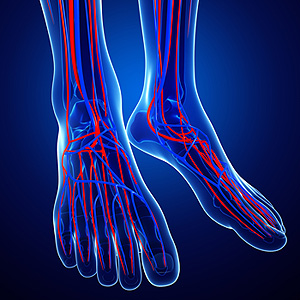 There are many causes of poor circulation in the feet, and two of the most common causes are diabetes and atherosclerosis. The latter is a process where fat builds up and narrows the blood vessels, making it difficult for the blood to flow. Some of the symptoms experienced may be cold feet, pain while walking, or the feet appearing pale. If you smoke, you may want to consider stopping because this may improve circulation. When healthy lifestyle habits are practiced, the chances of having poor circulation is decreased. This includes eating fruits and vegetables, in addition to drinking plenty of fresh water. It’s important to limit unhealthy fare such as foods that are fried, cream desserts, and fast foods. Making the decision to exercise will not only improve poor circulation, but will also benefit the entire body. Be sure to speak with a podiatrist if you think you have poor circulation in the feet.
There are many causes of poor circulation in the feet, and two of the most common causes are diabetes and atherosclerosis. The latter is a process where fat builds up and narrows the blood vessels, making it difficult for the blood to flow. Some of the symptoms experienced may be cold feet, pain while walking, or the feet appearing pale. If you smoke, you may want to consider stopping because this may improve circulation. When healthy lifestyle habits are practiced, the chances of having poor circulation is decreased. This includes eating fruits and vegetables, in addition to drinking plenty of fresh water. It’s important to limit unhealthy fare such as foods that are fried, cream desserts, and fast foods. Making the decision to exercise will not only improve poor circulation, but will also benefit the entire body. Be sure to speak with a podiatrist if you think you have poor circulation in the feet.
Poor circulation is a serious condition and needs immediate medical attention. If you have any concerns with poor circulation in your feet contact one of our podiatrists of Lovely Foot Associates, PC. Our doctors will treat your foot and ankle needs.
Poor Circulation in the Feet
Poor blood circulation in the feet and legs is can be caused by peripheral artery disease (PAD), which is the result of a buildup of plaque in the arteries.
Plaque buildup or atherosclerosis results from excess calcium and cholesterol in the bloodstream. This can restrict the amount of blood which can flow through the arteries. Poor blood circulation in the feet and legs are sometimes caused by inflammation in the blood vessels, known as vasculitis.
Causes
Lack of oxygen and oxygen from poor blood circulation restricts muscle growth and development. It can also cause:
Those who have diabetes or smoke are at greatest risk for poor circulation, as are those who are over 50. If you have poor circulation in the feet and legs it may be caused by PAD and is important to make changes to your lifestyle in order to reduce risk of getting a heart attack or stroke. Exercise and maintaining a healthy lifestyle will dramatically improve conditions.
As always, see a podiatrist as he or she will assist in finding a regimen that suits you. A podiatrist can also prescribe you any needed medication.
If you have any questions please feel free to contact our office located in Johnstown, PA . We offer the newest diagnostic and treatment technologies for all your foot and ankle needs.
Read more about Causes, Symptoms, and Treatment of Poor Blood Circulation in the Feet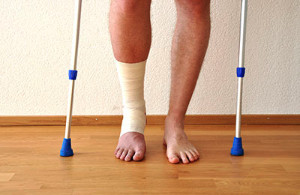 Joseph Jones was a 46 year old active runner, until a pain in his left heel was diagnosed as a bone spur causing him to go through surgery. During his recovery however, Jones refused to stop living an active lifestyle. Before Jones’ surgery, he had to wear a boot for three weeks. During these three weeks he performed activities such as stretching, lifting small weights, and doing sit-ups. After his surgery, Jones continued lifting weights and doing stretching exercises taught to him by his physical therapist. Aside from the activities Jones thought to do during his injury, other ideas you could partake in are as follows: yoga, exercising while sitting or lying down, using resistance bands, and exercising your legs. It is best to speak with your podiatrist before performing any of these exercises during an injury or before a surgical procedure.
Joseph Jones was a 46 year old active runner, until a pain in his left heel was diagnosed as a bone spur causing him to go through surgery. During his recovery however, Jones refused to stop living an active lifestyle. Before Jones’ surgery, he had to wear a boot for three weeks. During these three weeks he performed activities such as stretching, lifting small weights, and doing sit-ups. After his surgery, Jones continued lifting weights and doing stretching exercises taught to him by his physical therapist. Aside from the activities Jones thought to do during his injury, other ideas you could partake in are as follows: yoga, exercising while sitting or lying down, using resistance bands, and exercising your legs. It is best to speak with your podiatrist before performing any of these exercises during an injury or before a surgical procedure.
Foot surgery is sometimes necessary to treat a foot ailment. To learn more, contact one of our podiatrists of Lovely Foot Associates, PC. Our doctors will assist you with all of your foot and ankle needs.
When Is Surgery Necessary?
Foot and ankle surgery is generally reserved for cases in which less invasive, conservative procedures have failed to alleviate the problem. Some of the cases in which surgery may be necessary include:
What Types of Surgery Are There?
The type of surgery you receive will depend on the nature of the problem you have. Some of the possible surgeries include:
Benefits of Surgery
Although surgery is usually a last resort, it can provide more complete pain relief compared to non-surgical methods and may allow you to finally resume full activity.
Surgical techniques have also become increasingly sophisticated. Techniques like endoscopic surgery allow for smaller incisions and faster recovery times.
If you have any questions please feel free to contact our office located in Johnstown, PA . We offer the newest diagnostic and treatment technologies for all your foot and ankle needs.
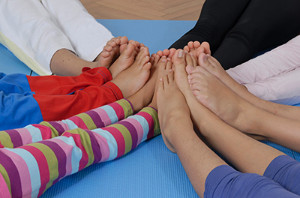 It typically takes 18 years for strong bones to fully develop in a child’s foot. Research has suggested that by observing your child’s posture and gait, common foot ailments may be avoided. A child typically begins to walk around 12 months of age, and going barefoot a majority of the time is beneficial to developing strong muscles. As a child’s foot develops, the shape of the foot may change, causing different size shoes to be worn every 6 months until the feet stop growing. There are several things you can do to optimize your child’s foot health, including choosing shoes with ample room for the toes to straighten and avoiding socks that are constrictive. When assessing your child’s shoe size, it’s important that both feet are measured correctly. The shoes should also feel comfortable while trying them on and should not have to be broken in. If your child complains of heel pain, especially if sports are an integral part of their daily activities, please consider a consultation with a podiatrist for an accurate diagnosis.
It typically takes 18 years for strong bones to fully develop in a child’s foot. Research has suggested that by observing your child’s posture and gait, common foot ailments may be avoided. A child typically begins to walk around 12 months of age, and going barefoot a majority of the time is beneficial to developing strong muscles. As a child’s foot develops, the shape of the foot may change, causing different size shoes to be worn every 6 months until the feet stop growing. There are several things you can do to optimize your child’s foot health, including choosing shoes with ample room for the toes to straighten and avoiding socks that are constrictive. When assessing your child’s shoe size, it’s important that both feet are measured correctly. The shoes should also feel comfortable while trying them on and should not have to be broken in. If your child complains of heel pain, especially if sports are an integral part of their daily activities, please consider a consultation with a podiatrist for an accurate diagnosis.
Making sure that your children maintain good foot health is very important as they grow. If you have any questions, contact one of our podiatrists of Lovely Foot Associates, PC. Our doctors can provide the care you need to keep you pain-free and on your feet.
Keeping Children's Feet Healthy
Having healthy feet during childhood can help prevent medical problems later in life, namely in the back and legs. As children grow, their feet require different types of care. Here are some things to consider...
Although babies do not walk yet, it is still very important to take care of their feet.
Avoid putting tight shoes or socks on his or her feet.
Allow the baby to stretch and kick his or her feet to feel comfortable.
As a toddler, kids are now on the move and begin to develop differently. At this age, toddlers are getting a feel for walking, so don’t be alarmed if your toddler is unsteady or ‘walks funny’.
As your child gets older, it is important to teach them how to take care of their feet.
Show them proper hygiene to prevent infections such as fungus.
Be watchful for any pain or injury.
Have all injuries checked by a doctor as soon as possible.
Comfortable, protective shoes should always be worn, especially at play.
If you have any questions please feel free to contact our office located in Johnstown, PA . We offer the newest diagnostic and treatment technologies for all your foot and ankle needs.
Read more about What to Do to Keep Your Child’s Feet Healthy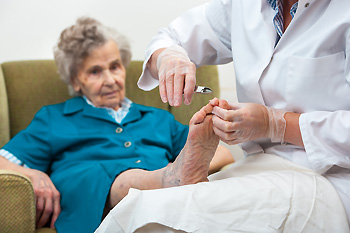 It’s important to practice good foot care, and this is especially true of the elderly population. This may include checking the feet daily, and if this proves to be a difficult task, a family member may be able to help. Recent research has shown that it's beneficial to elevate the feet as much as possible, and this will enable the blood to circulate freely. The feet typically get larger as the aging process occurs, and a key element in having healthy feet is to choose shoes that fit properly and comfortably. Some of the foot problems that elderly people need to be aware of developing are fungal and bacterial conditions, and this can include athlete’s foot and warts. Prevention of these conditions and others such as corns, calluses, and ingrown toenails is imperative in maintaining good foot health. Please consider scheduling a consultation with a podiatrist for additional information on how to take care of elderly feet.
It’s important to practice good foot care, and this is especially true of the elderly population. This may include checking the feet daily, and if this proves to be a difficult task, a family member may be able to help. Recent research has shown that it's beneficial to elevate the feet as much as possible, and this will enable the blood to circulate freely. The feet typically get larger as the aging process occurs, and a key element in having healthy feet is to choose shoes that fit properly and comfortably. Some of the foot problems that elderly people need to be aware of developing are fungal and bacterial conditions, and this can include athlete’s foot and warts. Prevention of these conditions and others such as corns, calluses, and ingrown toenails is imperative in maintaining good foot health. Please consider scheduling a consultation with a podiatrist for additional information on how to take care of elderly feet.
Proper foot care is something many older adults forget to consider. If you have any concerns about your feet and ankles, contact one of our podiatrists from Lovely Foot Associates, PC. Our doctors can provide the care you need to keep you pain-free and on your feet.
The Elderly and Their Feet
As we age we start to notice many changes in our body, but the elder population may not notice them right away. Medical conditions may prevent the elderly to take notice of their foot health right away. Poor vision is a lead contributor to not taking action for the elderly.
Common Conditions
Susceptible Infections
Diabetes and poor circulation can cause general loss of sensitivity over the years, turning a simple cut into a serious issue.
If you have any questions please feel free to contact our office located in Johnstown, PA . We offer the newest diagnostic and treatment technologies for all your foot and ankle needs.
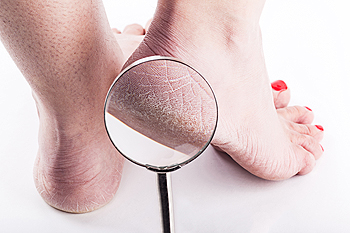 If severe dryness is experienced on the heels of the foot, it may lead to a condition referred to as cracked heels. Calluses will form to protect the skin, and may often split open, possibly leading to a painful infection. Poorly fitting shoes, shoes with exposed backs, obesity, and eczema are among the many reasons for cracked heels to develop. If daily activities include standing for long periods of time, further damage may occur because of the constant pressure the heels must endure. Applying a moisturizer daily will not only feel good, but will help to eliminate the dryness associated with cracked heels. A consultation with a podiatrist is advised to discuss the removal of calluses from severely cracked heels.
If severe dryness is experienced on the heels of the foot, it may lead to a condition referred to as cracked heels. Calluses will form to protect the skin, and may often split open, possibly leading to a painful infection. Poorly fitting shoes, shoes with exposed backs, obesity, and eczema are among the many reasons for cracked heels to develop. If daily activities include standing for long periods of time, further damage may occur because of the constant pressure the heels must endure. Applying a moisturizer daily will not only feel good, but will help to eliminate the dryness associated with cracked heels. A consultation with a podiatrist is advised to discuss the removal of calluses from severely cracked heels.
Cracked heels are unsightly and can cause further damage to your shoes and feet. If you have any concerns, contact one of our podiatrists from Lovely Foot Associates, PC. Our doctors can provide the care you need to keep you pain-free and on your feet.
Cracked Heels
Cracked heels appear unappealing and can make it harder for you walk around in sandals. Aside from looking unpleasant, cracked heels can also tear stockings, socks, and wear out your shoes. There are several methods to help restore a cracked heel and prevent further damage.
How Do You Get Them?
Dry skin is the number one culprit in creating cracked heels. Many athletes, walkers, joggers, and even swimmers suffer from cracked heels. Age and skin oil production play a role to getting cracked heels as well.
Promote Healing
Over the counter medicines can help, especially for those that need instant relief or who suffer from chronic dry feet.
Wear Socks – Wearing socks with medicated creams helps lock in moisture.
Moisturizers – Applying both day and night will help alleviate dryness which causes cracking.
Pumice Stones – These exfoliate and remove dead skin, which allows for smoother moisturizer application and better absorption into the skin.
Change in Diet
Eating healthy with a well-balanced diet will give the skin a fresh and radiant look. Your body responds to the kinds of food you ingest. Omega-3 fatty acids and zinc supplements can also revitalize skin tissue.
Most importantly, seek professional help if unsure how to proceed in treating cracked heels. A podiatrist will help you with any questions or information needed.
If you have any questions, please feel free to contact our office located in Johnstown, PA . We offer the newest diagnostic and treatment technologies for all your foot care needs.
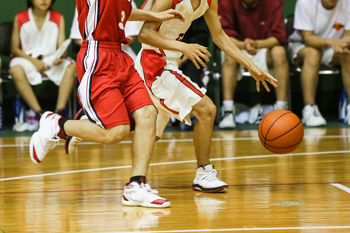 Demarcus Cousins of the New Orleans Pelicans recently ruptured his Achilles Tendon during a Friday night game. With just 15 seconds remaining, Cousins went to rebound on a free throw he missed and landed on his left leg. Now, Cousins must miss the remainder of the season from having to undergo surgery. Cousins will be immobilized for quite some time and have to go through physical therapy to regain strength and range of motion in his ankle and leg. It is said that the rate of recovery from surgery associated with this injury are high. With professional athletes having a different standard of physical health, this injury may hinder their athletic performance in the future. That being said, many people are curious to see how well Cousins will perform when he returns.
Demarcus Cousins of the New Orleans Pelicans recently ruptured his Achilles Tendon during a Friday night game. With just 15 seconds remaining, Cousins went to rebound on a free throw he missed and landed on his left leg. Now, Cousins must miss the remainder of the season from having to undergo surgery. Cousins will be immobilized for quite some time and have to go through physical therapy to regain strength and range of motion in his ankle and leg. It is said that the rate of recovery from surgery associated with this injury are high. With professional athletes having a different standard of physical health, this injury may hinder their athletic performance in the future. That being said, many people are curious to see how well Cousins will perform when he returns.
Achilles tendon injuries need immediate attention to avoid future complications. If you have any concerns, contact one of our podiatrists of Lovely Foot Associates, PC. Our doctors can provide the care you need to keep you pain-free and on your feet.
What Is the Achilles Tendon?
The Achilles tendon is a tendon that connects the lower leg muscles and calf to the heel of the foot. It is the strongest tendon in the human body and is essential for making movement possible. Because this tendon is such an integral part of the body, any injuries to it can create immense difficulties and should immediately be presented to a doctor.
What Are the Symptoms of an Achilles Tendon Injury?
There are various types of injuries that can affect the Achilles tendon. The two most common injuries are Achilles tendinitis and ruptures of the tendon.
Achilles Tendinitis Symptoms
Rupture Symptoms
Treatment and Prevention
Achilles tendon injuries are diagnosed by a thorough physical evaluation, which can include an MRI. Treatment involves rest, physical therapy, and in some cases, surgery. However, various preventative measures can be taken to avoid these injuries, such as:
If you have any questions please feel free to contact our office located in Johnstown, PA . We offer the newest diagnostic tools and technology to treat your foot and ankle needs.
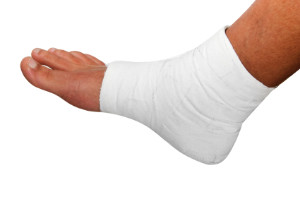 A common ailment that many tennis players are affected by are ankle sprains. The ligaments on the outside of the foot are weaker than those on the inside and may have difficulty in protecting the ankle if it should turn inward. You may have trouble differentiating between a sprain and a break, and it often becomes necessary to have an X-ray performed. Common symptoms may include severe pain and swelling, in addition to discoloration of the skin. Resting the foot is an important first step in healing from this injury, in addition to ceasing all activities including walking. The swelling will subside when the the foot is elevated and will generally feel better. After the recovery period begins, performing certain exercises will help the ankle to become stronger, and the tennis games can resume. One way to possibly prevent this injury is to wear proper footwear while playing tennis. Specifically, tennis shoes are designed in a way to prevent injuries. It would be advised to purchase a pair before partaking in the sport. If you think you may have sprained your ankle during a game of tennis or have any questions or concerns, scheduling an appointment with a podiatrist is advised.
A common ailment that many tennis players are affected by are ankle sprains. The ligaments on the outside of the foot are weaker than those on the inside and may have difficulty in protecting the ankle if it should turn inward. You may have trouble differentiating between a sprain and a break, and it often becomes necessary to have an X-ray performed. Common symptoms may include severe pain and swelling, in addition to discoloration of the skin. Resting the foot is an important first step in healing from this injury, in addition to ceasing all activities including walking. The swelling will subside when the the foot is elevated and will generally feel better. After the recovery period begins, performing certain exercises will help the ankle to become stronger, and the tennis games can resume. One way to possibly prevent this injury is to wear proper footwear while playing tennis. Specifically, tennis shoes are designed in a way to prevent injuries. It would be advised to purchase a pair before partaking in the sport. If you think you may have sprained your ankle during a game of tennis or have any questions or concerns, scheduling an appointment with a podiatrist is advised.
Ankle sprains are common but need immediate attention. If you need your feet checked, contact one of our podiatrists from Lovely Foot Associates, PC. Our doctors can provide the care you need to keep you pain-free and on your feet.
How Does an Ankle Sprain Occur?
Ankle sprains take place when the ligaments in your ankle are torn or stretched beyond their limits. There are multiple ways that the ankle can become injured, including twisting or rolling over onto your ankle, putting undue stress on it, or causing trauma to the ankle itself.
What Are the Symptoms?
Preventing a Sprain
Treatment of a Sprain
Treatment of a sprain depends on the severity. Many times, people are told to rest and remain off their feet completely, while others are given an air cast. If the sprain is very severe, surgery may be required.
If you have suffered an ankle sprain previously, you may want to consider additional support such as a brace and regular exercises to strengthen the ankle.
If you have any questions please feel free to contact our office located in Johnstown, PA . We offer the newest diagnostic and treatment technologies for all your foot and ankle needs.
If you have a toe that bends at the joint and points up, you may have what is referred to as a hammertoe. In severe cases where this affliction may affect everyday activities, surgery may be a viable option for relief. There are several different types of surgery that can be performed for the removal of one or more hammertoes. One type of surgery that is effective is referred to as a tendon transfer, and this is executed by pulling the tendon across the toe. This results in the toe becoming straighter. This may be beneficial, as it reduces pain and improves the appearance of the toe. Additionally, another type of surgery is known as a joint resection, and this is performed by possibly removing part of the bone and cutting the tendons and ligaments. If you are suffering from this condition, please schedule a consultation with a podiatrist to determine if surgery is appropriate for you.
Foot surgery is sometimes necessary to treat a foot ailment. To learn more, contact one of our podiatrists of Lovely Foot Associates, PC. Our doctors will assist you with all of your foot and ankle needs.
When Is Surgery Necessary?
Foot and ankle surgery is generally reserved for cases in which less invasive, conservative procedures have failed to alleviate the problem. Some of the cases in which surgery may be necessary include:
What Types of Surgery Are There?
The type of surgery you receive will depend on the nature of the problem you have. Some of the possible surgeries include:
Benefits of Surgery
Although surgery is usually a last resort, it can provide more complete pain relief compared to non-surgical methods and may allow you to finally resume full activity.
Surgical techniques have also become increasingly sophisticated. Techniques like endoscopic surgery allow for smaller incisions and faster recovery times.
If you have any questions please feel free to contact our office located in Johnstown, PA . We offer the newest diagnostic and treatment technologies for all your foot and ankle needs.
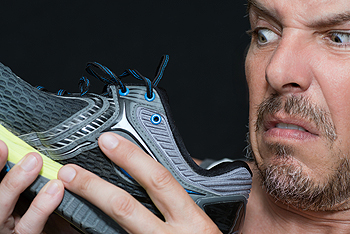 There are numerous sweat glands in the body, also known as eccrine glands. When these glands are overactive, excessive sweating can come from the feet, which is a condition known as plantar hyperhidrosis. Numerous side effects may often accompany this ailment because the skin is consistently moist. These may include scaling of the feet, especially in between the toes. Additionally, inflammation of the skin, blisters, and itchy feet are among the many conditions that can occur from hyperhidrosis. If the type of footwear that is worn includes insulated or waterproof shoes, the feet can produce an abnormal amount of sweat resulting in discomfort. It’s important to choose shoes that allows the feet to breath, and this will generally help to control any excessive sweating that may occur. A consultation with a podiatrist may be suggested for information and advice on how to control plantar hyperhidrosis.
There are numerous sweat glands in the body, also known as eccrine glands. When these glands are overactive, excessive sweating can come from the feet, which is a condition known as plantar hyperhidrosis. Numerous side effects may often accompany this ailment because the skin is consistently moist. These may include scaling of the feet, especially in between the toes. Additionally, inflammation of the skin, blisters, and itchy feet are among the many conditions that can occur from hyperhidrosis. If the type of footwear that is worn includes insulated or waterproof shoes, the feet can produce an abnormal amount of sweat resulting in discomfort. It’s important to choose shoes that allows the feet to breath, and this will generally help to control any excessive sweating that may occur. A consultation with a podiatrist may be suggested for information and advice on how to control plantar hyperhidrosis.
If you are suffering from hyperhidrosis contact one of our podiatrists of Lovely Foot Associates, PC. Our doctors can provide the care you need to attend to all of your foot and ankle needs.
Hyperhidrosis of the Feet
Hyperhidrosis is a rare disorder that can cause people to have excessive sweating of their feet. This can usually occur all on its own without rigorous activity involved. People who suffer from hyperhidrosis may also experience sweaty palms.
Although it is said that sweating is a healthy process meant to cool down the body temperature and to maintain a proper internal temperature, hyperhidrosis may prove to be a huge hindrance on a person’s everyday life.
Plantar hyperhidrosis is considered to be the main form of hyperhidrosis. Secondary hyperhidrosis can refer to sweating that occurs in areas other than the feet or hands and armpits. Often this may be a sign of it being related to another medical condition such as menopause, hyperthyroidism and even Parkinson’s disease.
In order to alleviate this condition, it is important to see your doctor so that they may prescribe the necessary medications so that you can begin to live a normal life again. If this is left untreated, it is said that it will persist throughout an individual’s life.
A last resort approach would be surgery, but it is best to speak with your doctor to find out what may be the best treatment for you.
If you have any questions please feel free to contact our office located in Johnstown, PA . We offer the newest diagnostic and treatment technologies for all your foot and ankle needs.
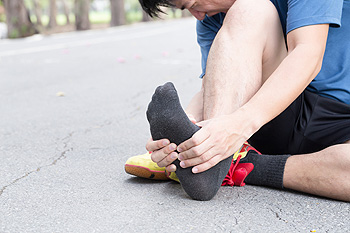 Well-developed arches in the feet provide the necessary balance the body needs to achieve maximum flexibility and stability. When this arch is not developed, the condition is called flat feet, also known as fallen arches. Babies are typically born with flat feet, and the arch generally develops in childhood. Recent research has shown there are two types of flat feet: flexible and rigid. A partial arch is noticeable in the patient that has flexible flat feet, while there is no arch present at all in rigid flat feet. As the aging process transpires, there may be several reasons why flat feet develop, including weight gain and possible foot injuries. Runners with this condition may find that choosing shoes to wear while jogging that offer additional support may feel more comfortable. It’s suggested to consult with a podiatrist for a proper diagnosis or for additional information.
Well-developed arches in the feet provide the necessary balance the body needs to achieve maximum flexibility and stability. When this arch is not developed, the condition is called flat feet, also known as fallen arches. Babies are typically born with flat feet, and the arch generally develops in childhood. Recent research has shown there are two types of flat feet: flexible and rigid. A partial arch is noticeable in the patient that has flexible flat feet, while there is no arch present at all in rigid flat feet. As the aging process transpires, there may be several reasons why flat feet develop, including weight gain and possible foot injuries. Runners with this condition may find that choosing shoes to wear while jogging that offer additional support may feel more comfortable. It’s suggested to consult with a podiatrist for a proper diagnosis or for additional information.
Flatfoot is a condition many people suffer from. If you have flat feet, contact one of our podiatrists from Lovely Foot Associates, PC. Our doctors will treat your foot and ankle needs.
What Are Flat Feet?
Flatfoot is a condition in which the arch of the foot is depressed and the sole of the foot is almost completely in contact with the ground. About 20-30% of the population generally has flat feet because their arches never formed during growth.
Conditions & Problems:
Having flat feet makes it difficult to run or walk because of the stress placed on the ankles.
Alignment – The general alignment of your legs can be disrupted, because the ankles move inward which can cause major discomfort.
Knees – If you have complications with your knees, flat feet can be a contributor to arthritis in that area.
Symptoms
Treatment
If you are experiencing pain and stress on the foot you may weaken the posterior tibial tendon, which runs around the inside of the ankle.
If you have any questions please feel free to contact our office located in Johnstown, PA . We offer the newest diagnostic and treatment technologies for all your foot and ankle needs.